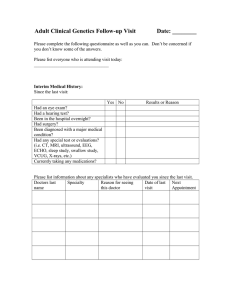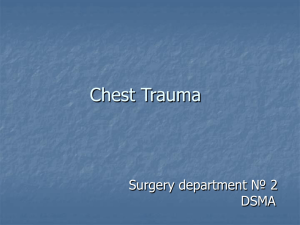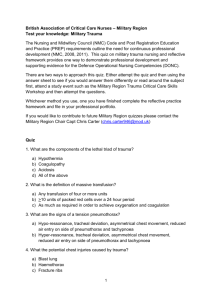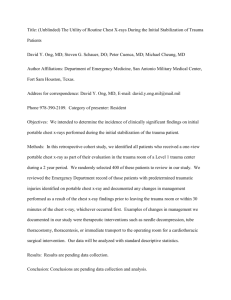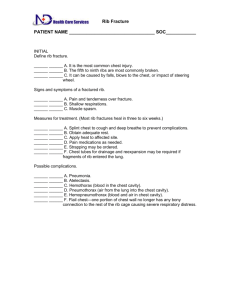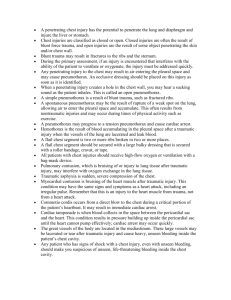Thoracic Trauma
advertisement
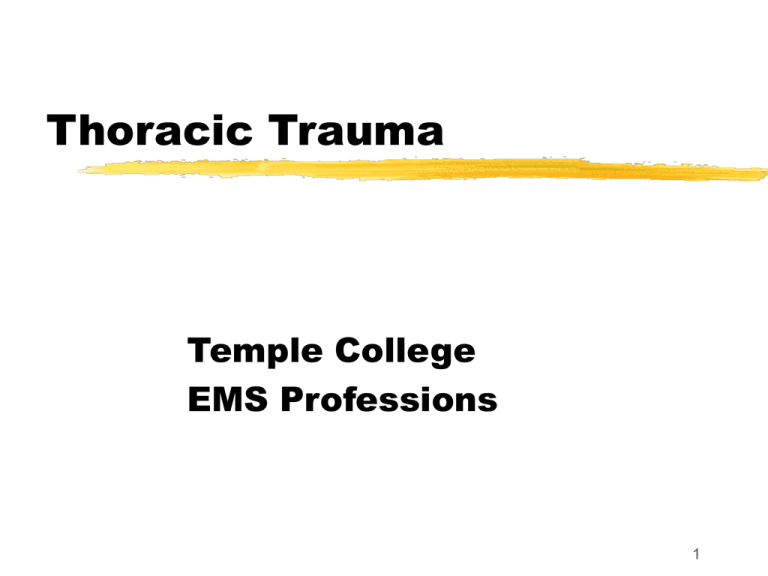
Thoracic Trauma Temple College EMS Professions 1 Chest Trauma Second leading cause of trauma deaths after head injury About 20% of all trauma deaths 2 Chest Trauma Initial exam directed toward: Open pneumothorax Flail chest Tension pneumothorax Massive hemothorax Cardiac tamponade 3 Rib Fracture Most common chest injury More common in adults than children Especially common in elderly Ribs form rings Consider possibility of break in two places 4 Rib Fracture Most commonly 5th to 9th ribs Poor protection 5 Rib Fracture Fractures of 1st, 2nd ribs require high force Frequently have injury to aorta or bronchi 30% will die 6 Rib Fracture Fractures of 8th to 12th ribs can damage underlying abdominal solid organs: Liver Spleen Kidneys 7 Rib Fracture Signs and Symptoms Localized pain, tenderness Increases when patient: Coughs Moves Breathes deeply Chest wall instability Deformity, discoloration Associated pneumo or hemothorax 8 Rib Fracture Management High concentration O2 Splint using pillow, swathes Encourage patient to breath deeply 9 Rib Fracture Management Monitor elderly and COPD patients carefully Broken ribs can cause decompensation Patients will fail to breath deeply and cough, resulting in poor clearance of secretions 10 Flail Chest Two or more adjacent ribs broken in two or more places Produces free-floating chest wall segment Usually secondary to blunt trauma More common in older patients 11 Flail Chest Signs and Symptoms Paradoxical movement May NOT be present initially due to intercostal muscle spasms Be suspicious in any patient with chest wall: • Tenderness • Crepitus 12 Flail Chest Consequences Pain, leading to decreased ventilation Increased work of breathing Contusion of lung 13 Flail Chest Management Establish airway Suspect spinal injuries Assist ventilation with BVM and oxygen Stabilize chest wall 14 Simple Pneumothorax Air in pleural space Partial or complete lung collapse occurs 15 Simple Pneumothorax Causes Chest wall penetration Fractured rib lacerating lung Paper bag effect May occur spontaneously following: Exertion Coughing Air Travel 16 Simple Pneumothorax Signs and Symptoms Pain on inhalation Difficulty breathing Tachypnea Decreased or absent breath sounds Severity of symptoms depends on size of pneumothorax, speed of lung collapse, and patient’s health status 17 Simple Pneumothorax Management Establish airway Suspect spinal injury based on mechanism High concentration O2 with NRB Assist decreased or rapid respirations with BVM Monitor for tension pneumothorax 18 Open Pneumothorax Hole in chest wall Allows air to enter pleural space Larger hole = Greater chance air will enter there than through trachea “Sucking Chest Wound” 19 Open Pneumothorax Management Close hole with occlusive dressing High concentration O2 Assist ventilations Consider transport on injured side Monitor for tension pneumothorax 20 Tension Pneumothorax One-way valve forms in lung or chest wall Air enters pleural space; cannot leave Air is trapped in pleural space Pressure rises Pressure collapses lung 21 Tension Pneumothorax Trapped air pushes heart, lungs away from injured side Vena cavae become kinked Blood cannot return to heart Cardiac output falls 22 Tension Pneumothorax Signs and Symptoms Extreme dyspnea Restlessness, anxiety, agitation Decreased breath sounds Hyperresonance to percussion Cyanosis Subcutaneous emphysema 23 Tension Pneumothorax Signs and Symptoms Rapid, weak pulse Decreased BP Tracheal shift away from injured side Jugular vein distension Early dyspnea/hypoxia - Late shock 24 Tension Pneumothorax Management Secure airway High concentration O2 with NRB If available, request ALS intercept for pleural decompression 25 Hemothorax Blood in pleura space Most common result of major chest wall trauma Present in 70 to 80% of penetrating, major non-penetrating chest trauma 26 Hemothorax Signs and Symptoms Rapid, weak pulse Cool, clammy skin Restlessness, anxiety Thirst Chills Hypotension Collapsed neck veins 27 Hemothorax Signs and Symptoms Decreased breath sounds Dullness to percussion Dyspnea Ventilatory failure Shock precedes ventilatory failure 28 Hemothorax Management Secure airway Assist breathing with high concentration O2 Rapid transport 29 Traumatic Asphyxia Blunt force to chest causes Increased intrathoracic pressure Backward flow of blood out of heart into vessels of upper chest, neck, head 30 Traumatic Asphyxia Signs and Symptoms Possible sternal fracture or central flail chest Shock Purplish-red discoloration of: Head Neck Shoulders Blood shot, protruding eyes Swollen, cyanotic lips 31 Traumatic Asphyxia Name given because patients looked like they had been strangled or hanged 32 Traumatic Asphyxia Management Airway with C-spine control Assist ventilations with high concentration O2 Spinal stabilization Rapid transport 33 Cardiovascular Trauma Any patient with significant blunt or penetrating trauma to chest has heart/great vessel injury until proven otherwise 34 Myocardial Contusion Bruise of heart muscle Most common blunt cardiac injury Usually due to steering wheel impact 35 Myocardial Contusion Behaves like acute MI May produce arrhythmias May cause cardiogenic shock, hypotension 36 Myocardial Contusion Signs and Symptoms Cardiac arrhythmias after blunt chest trauma Angina-like pain unresponsive to nitroglycerin Chest pain independent of respiratory movement Suspect in all blunt chest trauma 37 Myocardial Contusion Management High concentration O2 Transport Consider ALS intercept 38 Cardiac Tamponade Rapid accumulation of blood in space between heart, pericardium Heart compressed Blood entering heart decreases Cardiac output falls 39 Cardiac Tamponade Signs and Symptoms Hypotension unresponsive to treatment Increased central venous pressure (distended neck/arm veins in presence of decreased arterial BP) Small quiet heart (decreased heart sounds) Beck’s Triad 40 Cardiac Tamponade Signs and Symptoms Narrowing pulse pressure Pulsus paradoxicus Radial pulse becomes weak or disappears when patient inhales 41 Cardiac Tamponade Management Secure airway High concentration O2 Rapid transport Definitive treatment is pericardiocentesis followed by surgery 42 Traumatic Aortic Aneurysm Caused by sudden decelerations, massive blunt force: Vehicle collisions Falls from heights Crushing chest trauma Blunt chest trauma Animal kicks 43 Traumatic Aortic Aneurysm Rupture usually occurs just beyond left subclavian artery Attachment of aorta to pulmonary artery at this point produces shearing force on aortic arch 44 Traumatic Aortic Aneurysm Signs and Symptoms Increased BP in arms in absence of head injury Decreased femoral pulses with full arm pulses Respiratory distress Ache in chest, shoulders, lower back, abdomen. (Only 25% of patients) Detection requires high index of suspicion 45 Traumatic Aortic Aneurysm Management High concentration oxygen Assist ventilation Suspect spinal injury Rapid transport 46 Associated Abdominal Trauma Diaphragm forms dome that extends up into rib cage Trauma to chest below 4th rib = Abdominal injury until proven otherwise 47

